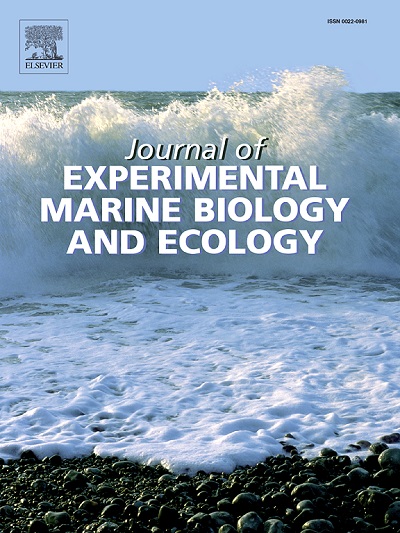Dive wiggles as a proxy of prey consumption in krill-feeding penguins
IF 1.8
3区 生物学
Q3 ECOLOGY
Journal of Experimental Marine Biology and Ecology
Pub Date : 2025-06-11
DOI:10.1016/j.jembe.2025.152115
引用次数: 0
Abstract
The dive profiles of pursuit-diving marine predators are often used to infer foraging behaviour, including potential indicators of prey consumption. ‘Wiggles’ are undulations in dive profiles that relate to foraging activity in a variety of marine predators. In penguins, wiggles are sometimes used as a proxy for prey consumption (e.g., catch per unit effort, CPUE), but this relationship remains poorly validated and likely varies with diet. We deployed animal-borne video cameras and depth recorders on chinstrap penguins (Pygoscelis antarcticus; n = 37) and identified over 17,000 euphausiid prey captures - mainly Antarctic krill (Euphausia superba) - during dives deeper than 3 m (n = 2458 dives). Using the video-observed prey captures as a reference, we tested how well various wiggle metrics derived from 1 Hz depth data predicted krill consumption by the penguins. Wiggle metrics generally showed a positive but noisy and highly variable relationship with the number of krill captured per dive, with association strength varying among metrics. While it is tempting to infer detailed foraging behaviours from dive wiggles (including ‘bottom distance’ generated by the R package diveMove), our results show: (1) notable rates of foraging – non-foraging dive misclassification; (2) only moderate agreement between CPUE estimated from wiggle counts and video observations; and (3) imprecise predictive models of actual prey consumption. While wiggle analyses offer some insight into prey consumption of krill-feeding penguins, our results suggest that alternative methods (e.g., acceleration-based indices) are needed to obtain more robust quantitative estimates of prey consumption.
在以磷虾为食的企鹅中,潜水摆动代表了猎物的消耗
追逐潜水的海洋捕食者的潜水剖面经常被用来推断觅食行为,包括潜在的猎物消耗指标。“摆动”是潜水剖面上的波动,与各种海洋捕食者的觅食活动有关。在企鹅中,摆动有时被用作猎物消耗的代表(例如,单位努力捕获量,CPUE),但这种关系仍然缺乏验证,可能因饮食而异。我们在帽带企鹅(Pygoscelis antarcticus;n = 37),并在深度超过3米(n = 2458次)的潜水中发现了超过17,000只南极磷虾(主要是南极磷虾)的猎物。以视频观察到的猎物捕获作为参考,我们测试了从1赫兹深度数据中得出的各种摆动指标对企鹅磷虾消耗的预测效果。摆动指标通常与每次潜水捕获的磷虾数量呈正相关,但存在噪声和高度可变的关系,各指标之间的关联强度各不相同。虽然很容易从潜水摆动(包括R包diveMove生成的“底部距离”)中推断出详细的觅食行为,但我们的结果表明:(1)觅食-非觅食潜水误分类率显著;(2)摆动计数估算的CPUE值与视频观测值的一致性不高;(3)对实际猎物消耗量的不精确预测模型。虽然摆动分析提供了一些关于以磷虾为食的企鹅的猎物消耗的见解,但我们的研究结果表明,需要其他方法(例如,基于加速度的指数)来获得更可靠的猎物消耗的定量估计。
本文章由计算机程序翻译,如有差异,请以英文原文为准。
求助全文
约1分钟内获得全文
求助全文
来源期刊
CiteScore
4.30
自引率
0.00%
发文量
98
审稿时长
14 weeks
期刊介绍:
The Journal of Experimental Marine Biology and Ecology provides a forum for experimental ecological research on marine organisms in relation to their environment. Topic areas include studies that focus on biochemistry, physiology, behavior, genetics, and ecological theory. The main emphasis of the Journal lies in hypothesis driven experimental work, both from the laboratory and the field. Natural experiments or descriptive studies that elucidate fundamental ecological processes are welcome. Submissions should have a broad ecological framework beyond the specific study organism or geographic region.
Short communications that highlight emerging issues and exciting discoveries within five printed pages will receive a rapid turnaround. Papers describing important new analytical, computational, experimental and theoretical techniques and methods are encouraged and will be highlighted as Methodological Advances. We welcome proposals for Review Papers synthesizing a specific field within marine ecology. Finally, the journal aims to publish Special Issues at regular intervals synthesizing a particular field of marine science. All printed papers undergo a peer review process before being accepted and will receive a first decision within three months.

 求助内容:
求助内容: 应助结果提醒方式:
应助结果提醒方式:


